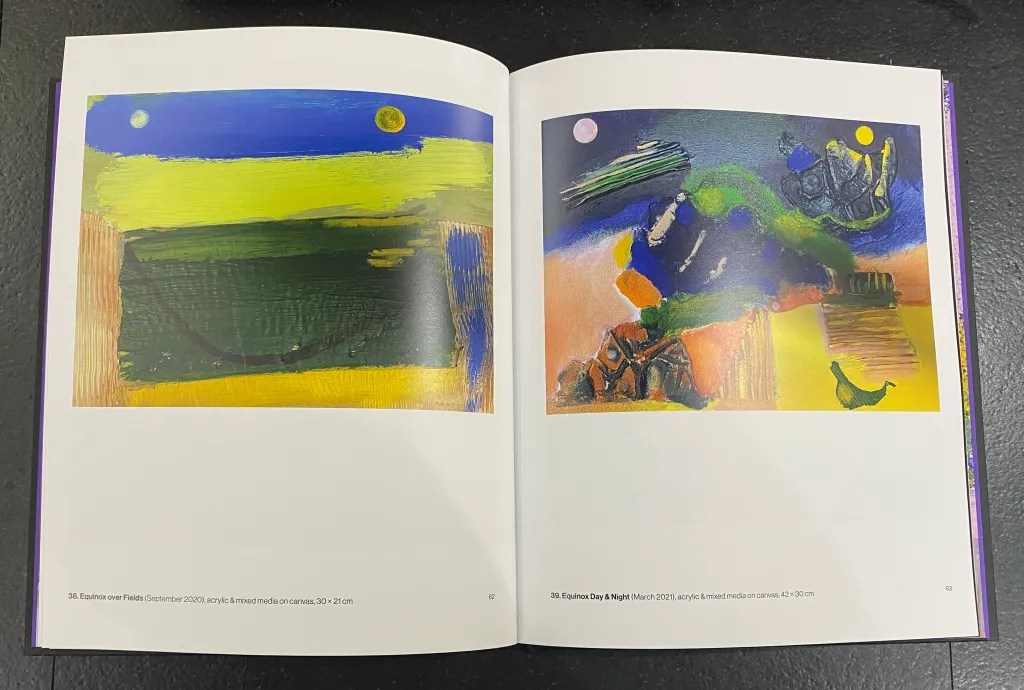
By Dr. James Fox | British Art Historian & Broadcaster
If some artists are born and others made, Tom Glynn is undoubtedly one of the former. Growing up in West Sussex in the 1950s and 60s, he possessed a voracious aesthetic sensibility from the start. Not long after beginning at school, aged five, he spent the best part of a week constructing an elaborate tunneled structure in a sandpit – astonishing his teachers in the process. In subsequent years he fashioned animals from plasticine, made assemblages from scavenged wood, sketched on scraps of paper, and built miniature model theatres. As he grew older, Glynn became interested in earlier artists, establishing what he has called a ‘lifelong friendship’ with the work of Picasso, Matisse, Arp and Brancusi. But his ambitions to become a serious artist himself only crystallized at the age of fifteen, when he visited the studio of the great post-war British sculptor, Robert Adams. Glynn even showed the older artist some of his own creations, which Adams is said to have admired.
Glynn is one of the most inventive British artists working today. Moving effortlessly between artworks, materials and techniques, he makes beautiful, playful and sophisticated images, infused with a deeply-felt love of the world around him.

Glynn attended Farnham School of Art between 1974 and 1977, where he was tutored by Ben Franklin, Robin Ball, Leszek Muszynski, Bryan Ingham and Phyllida Barlow. In the same period he also met William Turnbull, Kim Lim, Nicholas Pope, and David Nash – with whom he planted the masterpiece of land art, Ash Dome. Glynn, like Nash, was primarily making sculptures at the time – often on a vast scale. Towards the end of his degree he created two huge totemic towers, more than three meters high, with frames made from wooden packing crates.
Their roughly-hewn surfaces were peppered with mysterious apertures, boarded-up doorways, and interior spaces visible through wooden slats, housing everyday objects that looked like sacred relics. Glynn, who has always been fascinated by ancient cultures, and has visited archaeological sites around the world, conceived the pieces as monumental ruins of an imagined civilization. Both were exhibited at the Northern Young Contemporaries exhibition at the Whitworth Gallery in Manchester in 1975.

Unsurprisingly, Glynn’s ambitious and allusive sculptures attracted attention. Not long after leaving college he was commissioned to make a similarly large sculpture for BBRK Ltd, a successful advertising and production company based at Shep perton Studios in Surrey. It was another elaborate tower, this time constructed from metal, in which flat sheets of steel were curled into fish-eye forms, then linked together by a series of brackets into a tapering pagoda-like structure.
The piece, which was almost as tall as Glynn’s totems, sat outside the front of BBRK’s main office for many years, greeting countless executives and creatives from the worlds of film and advertising. Glynn in fact briefly entered the industry himself, making props and sets for a number of celebrated television adverts. But ultimately he decided to embark on a long and distinguished career in art education. It was only on retirement, in 2008, that he once again devoted himself to making art full-time.




‘Late Glynn’ – if we can call it that – is a large and diverse body of work, fuelled by a lifetime of close-looking, careful making, and above all a deeply-felt admiration for earlier artists that, for all its nods and allusions, never subsides into pastiche (this admiration is recorded in Glynn’s remarkable list of artistic influences reproduced at the end of this volume). Some of the earliest works in the book, which date back to 2011, are seemingly ad hoc constructions made from wooden offcuts and metal mechanisms, in which, through squinted eyes, one can just discern the physiognomy of faces.
Others reprise but re-imagine the boxed constructions associated with Joseph Cornell. City Moonscape, made in May 2016, is an homage to one of Glynn’s favourite artists, the American sculptor (and, like Cornell, a fellow scavenger) Louise Nevelson. It imagines a view looking down over a vast city at night, perhaps Nevelson’s New York. The piece is covered in carbon black paint to simulate its nocturnal setting but is a thrilling sight to behold. The source materials – driftwood, furniture turnings, cupboard handles, pegs, and towards the centre, a large slate coaster, which doubles up as a moon – produce a rhythmic interaction of rectilinear and curvilinear forms, their dynamism enhanced by a frame that seems to crumble around them.

Many of Glynn’s pieces are inspired by the work of other artists. After seeing David Hockney’s painting Cleaning Teeth, Early Evening (10pm) W11 (1962) – which depict ed two men lying in bed together fellating phallic toothpaste tubes – Glynn made his own sculptural equivalent. Reclining Forms (2017) consists of two pieces of wood laid down on sacking cloth and sealed in a Joseph Cornell-style box. The wooden forms are clearly intended to be the men: from each protrudes a knotted rope that, like Hockney’s toothpaste tubes, brings to mind the form of a penis.
But like all of Glynn’s work, the assemblage is layered with references and associations: the title alludes to those given to sculptures by Henry Moore and Barbara Hepworth; the incongruous concatenation of found objects and materials recalls Surrealist objets trouvés; while the two cork balls (and their associated holes) even suggest the possibility of viewer interaction. ‘My thinking and intention was also the playful idea of contained ball bearings in Victorian bagatelles’, Glynn writes, ‘where the aim is to try to get the ball into the holes’.

In recent years Glynn has focused increasingly on painting, though his canvases are invariably invested with a deep-rooted sculptural sensibility. He applies acrylic paint in thick, rippled textures; sometimes makes or paints his own frames; and adorns surfaces with pasted papers, photographs, and cut-outs from cereal or biscuit boxes. Equinox 1 is one such augmented painting. The picture is clearly inspired by Paul Nash’s own series of equinoxes, about the ongoing cycles of nature, painted at the end of his life. Just as in Nash’s Landscape of the Vernal Equinox (1944), Glynn shows both the sun and the moon in the sky at the same time, above a mysterious undulating landscape.
But Glynn enlivens the painting with materials his predecessor would never have dreamed of using. The radiant yellow hills are matted with scrim; an outcrop of rocks is fashioned from cork; the furrows of the fields are evoked with corrugated cardboard; and the tree (and a flock of almost imperceptible sheep beside it) is made from children’s toys that have been glued onto the picture and painted. It is characteristically inventive and humorous, but carries the same existential concerns that exercised Nash. ‘I have a great sense of mortality’, Glynn says. ‘What’s going to happen beyond. And what’s going on now’.

For all its variety, Glynn’s oeuvre is united by a mastery of form and colour. His paintings bubble up into vivid cerulean blues, retina-resonating reds, vital vegetal greens, and yellows so radiant that they seem to cause sunburn. Glynn’s control of his pictorial ingredients is perhaps best seen in his abstractions, including the grid like quilts of colour seen in Fragmented Landscape and Artist Palette, and bold gesturalist efforts such as From the Darkness (cat. 46) and Darkness Beyond (cat. 45) that evoke the work of Ivon Hitchens and Howard Hodgkin.
Aerial Landscape 2 (2012), inspired by the aviation-themed canvas of Peter Lanyon, is particularly impressive: a blizzard of initially unrecognizable forms gradually coagulate into the titular landscape: the puffed whites of clouds, the dark blue depths of rolling seas, the scalloped greens of trees and bushes, and the pink frames of a window past which the world races by. (cat. 2) The painting, as Glynn has written, is about ‘memories, momentary interactions, glances, thoughts and explorations through the physical environment’. It is also a technical tour de force: an amalgam of disparate objects, planes, viewpoints, brushstrokes and colours, woven together into exquisite harmony. It is as accomplished as anything painted by Peter Lanyon.

Despite this plethora of artistic influences, Glynn’s most consistent source of inspiration was not an artist at all, but his late mother, Margaret. It was Margaret – her self a long-time art lover – who nourished her son’s latent creativity from childhood, encouraging him to exercise his visual imagination, providing him with art materials and books to fuel his incipient talents, and later instilling in him the confidence to pivot to full-time art practice.
Glynn made at least one mature work for Margaret – the monumental Landscape with Rainbow, in which a group of ancient English monoliths stand beneath a cloudy sky, animated by two celestial orbs and a brilliant looping rainbow. It is a moving reflection on the passing of time as well as hope for the future, and one that Margaret asked her son never to sell. In truth, none of the artworks collected in this book would have been made without her relentless support, and all of them are – in one way or another – dedicated to her memory.




Tom Glynn is a rare breed: an artist who can move effortlessly between artforms, materials, scales and registers, equally adept at making miniature paintings and monumental sculptures. And yet all of his work is unmistakably English in mood. His images are populated by the country’s Neolithic monuments and pastoral landscapes, and informed by the many artists who inhabited those places before him. Glynn is driven by the same Romantic spirit that motivated Palmer and Turner, Nash and Piper, Wallis, Lanyon and Hockney, but his art is never anything but his own. It is, after all, underpinned by an urge that has coursed through his veins since he first stepped foot in a sandpit.

James Fox – the celebrated British Art Historian and Broadcaster – has composed a comprehensive appraisal and detailed survey of Glynn’s body of work, which spans decades of artistic practice through Painting, Sculpture and Assemblage, warranting him the title of a Modern Romantic. This hardback publication comprises of 118 pages with an artist statement, a foreword by a leading art critic, a critical analysis of Glynn’s artistic practice, 79 illustrations and a biography. RRP £35.
TomGlynnFineArt.com
The World Art News (WAN) is not liable for the content of this publication. All statements and views expressed herein are only an opinion. Act at your own risk. No part of this publication may be reproduced without written permission. © The World Art News
Categories: Artists, Decor, Europe, Investigations, Modern Art, Opinion, Sculpture




















Tom Is a mythic figure of UK Art &Artists, he’s met everyone, & now the public gets a closer look at this truly modern romantic artist’s work. Bravo!
Many thanks Jack